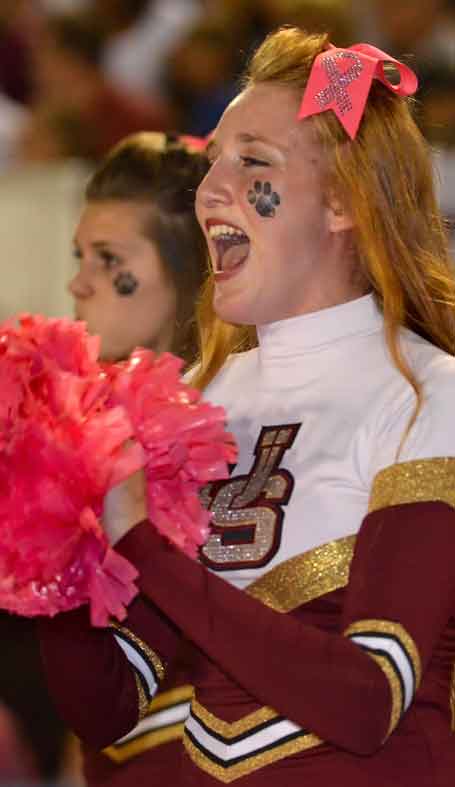While players on the Trinity League’s football teams are slugging it out on the field on Friday nights, collecting their share of bruises and occasionally more significant injuries, cheer, song, pep and dance squads from the schools are expending similar efforts in support, and sometimes facing similar injuries.
In years past, cheerleaders, song leaders and other spirit groups needed enthusiastic personalities and loud voices to cheer. Today’s groups require highly trained athletic bodies to perform intricate gymnastic and tumbling stunts. And all of the Trinity League’s coed schools have competitive cheer squads (squads from Connelly and Rosary high schools perform at Servite sporting events). Cheerleading and its attendant disciplines have become sports unto themselves, with attendant rewards and risks.
“National data suggest that after football, cheerleading ranks second in catastrophic injuries when compared to all sports,” says Rosary Assistant Principal of Student Services Jen Almand, the administrator for the cheer, song and pep squads. “Like football players, cheerleaders suffer from sprained wrists, twisted ankles, damaged knees, strained backs and other injuries.”
When did cheerleading get so tough?
“Cheerleading has always been athletic, but when the aspect of competition was added, in my opinion, it transformed cheerleading into a sport,” says JSerra pep squad coach Mandy Morgan. “Cheerleading can be a dangerous sport, especially when the athletes are not properly trained for the skill level they are performing at. These girls are constantly defying gravity by flying through the air and flipping upside down. This sport utilizes every muscle of the body, so it is imperative that each athlete is in top shape. Although injuries occur, like in any sport, when the proper progressions and key elements are met, it takes a lot of the danger out of this sport.”
 Cheerleading started in Great Britain in the 1860s, and came to America two decades later at Princeton University with all-male cheering squads. But when did the Orange County competition really heat up?
Cheerleading started in Great Britain in the 1860s, and came to America two decades later at Princeton University with all-male cheering squads. But when did the Orange County competition really heat up?
Flashy dance routines and gymnastic stunts became more popular in the 1980s, and by 1997 cheerleading was recognized as an independent sport, attracting national attention. Cheerleading organizations began to regulate moves and emphasize safety, and in 2003 a national council was launched to offer safety workshops to cheerleading squads and their coaches.
“I first experienced cheerleading becoming a sport in 1995 when I joined varsity cheer at Nogales High School,” Connelly cheer coach Darla Serrano says. “It was my first year as a cheerleader and also the first year Nogales cheer incorporated stunts into the routines and participated in competition cheer. I was a gymnast for many years and I can tell you firsthand from experience that competitive cheer/stunting was much harder physically than anything I ever did as a gymnast.
“Anyone who thinks [cheerleading is not a sport] should try learning and performing a two-minute, choreographed routine that incorporates cheers, dancing and stunts. It’s very hard work.”
Cheerleading originated in the 19th century as a means for boosting school spirit for spectators in the stands and as a spur to team performance. Today it is a worldwide industry with competitions, trophies and large prizes. Commonly, it is partnered with a school, college, youth league or athletic association, but it also can operate independently in the professional and all-star ranks. There are an estimated 3.5 million cheerleaders in the U.S., not including dance team members, gymnasts, and other affiliated participants.
”While our cheer team can execute all of the standard stunts associated with cheerleading, such as basket toss and flyer, we strive to put together programs that do not focus on stunting, but rather on the totality of the performance, whether it is in competition or on the field or court,” says Almand, whose Rosary dance team has won nine national championships and two consecutive ESPY Awards. The school’s cheer squad earned second place at a world competition in 2014.
Almand says her scholar-athletes strive “to be unique and innovative in all aspects of cheer and dance: choreography, gymnastics, teamwork, athleticism, gracefulness and safety.”
In addition to national competitions, the JSerra cheer and pep squads create different routines for the different sports. “It’s incredible how much material these girls learn and perform within their year-long sport,” Morgan says.


